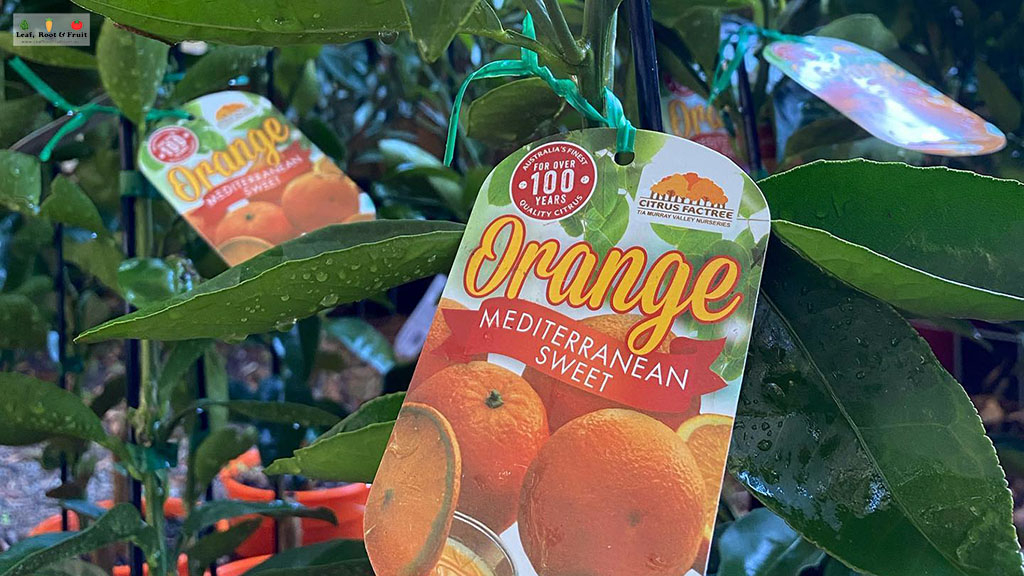
Of all the fruit trees, Citrus are the most popular backyard trees in Melbourne. Citrus trees are attractive evergreens and fit well into the garden landscape with their glossy green foliage, beautiful white scented blossoms and colourful fruit. Here’s our guide on where in the garden you should plant your citrus trees with plenty of advice to ensure you give your new trees the best start possible!
Site selection for citrus trees
Citrus plants grow best in an open position where they receive at least 5 hours of full sun each day, during the growing season (October to April). The more open and sunny the position is, the more accumulation of sugars in the fruit. To maximise heat units and frost protection, plant your trees in a north facing position, preferably in front of a brick wall. The brick wall will reflect heat and light onto the tree during the day and radiate absorbed heat back onto the tree during the night time.
Most citrus grow and fruit best, in a temperature range between 20 and 32oC. Both above and below this range, growth slows and stops completely below 13 degrees C and above 38 degrees C.
Shelter is important, because strong winds damage young growth, blossom and developing fruit.
Freedom from frost is desirable, although most citrus will tolerate light frost, once they are well established. Late winter and early spring frosts can damage young blossom bearing shoots. Trifoliata rootstocks induce a shorter growing season, and help reduce the risk of damage.
We grow many citrus trees on our property in Kyneton. Here the winters are very severe compared to Melbourne. The citrus grove is protected from wind by a perimeter hedge. The tank and other elemnts provide thermal mass. The established citrus trees thrive in this area and are very productive.
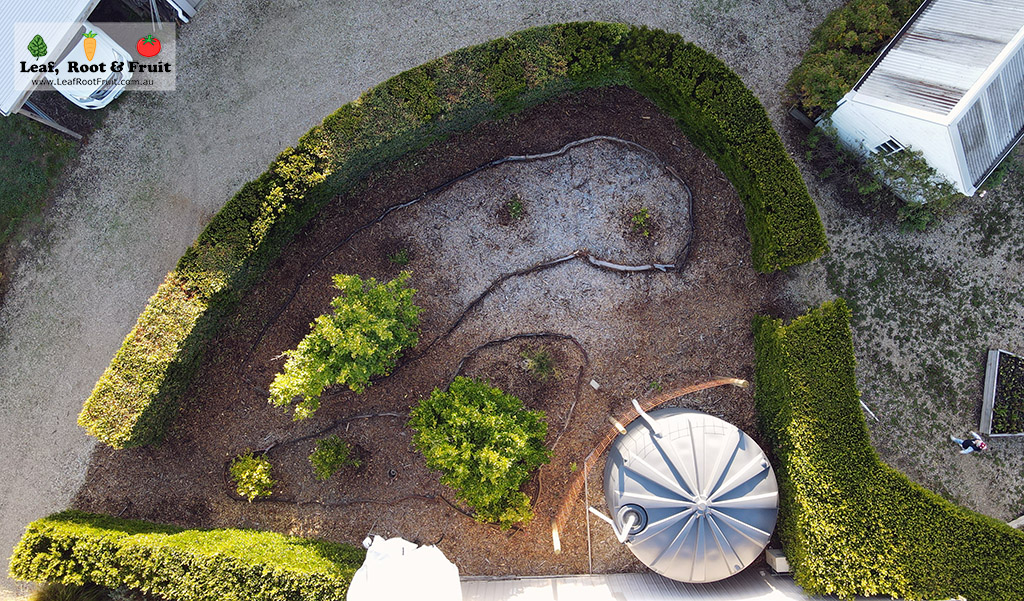
Citrus growth and fruiting can be limited by the tree’s tolerance to winter cold and by the amount of heat, required in a season to mature the fruit. In colder areas such as the hills, grapefruit, ‘Valencia’ orange and sometimes ‘Washington’ navel orange may not mature fully and may develop “off-flavours”. In areas prone to severe frosts, limes will not survive and the thin skins of some mandarins may be damaged.
In difficult climates, it may be better to grow trees in tubs in the sunniest and most weather protected site available. A north-facing brick wall will radiate heat at night to keep temperatures more constant. In winter, trees can be moved to a more protected area, away from frosts.
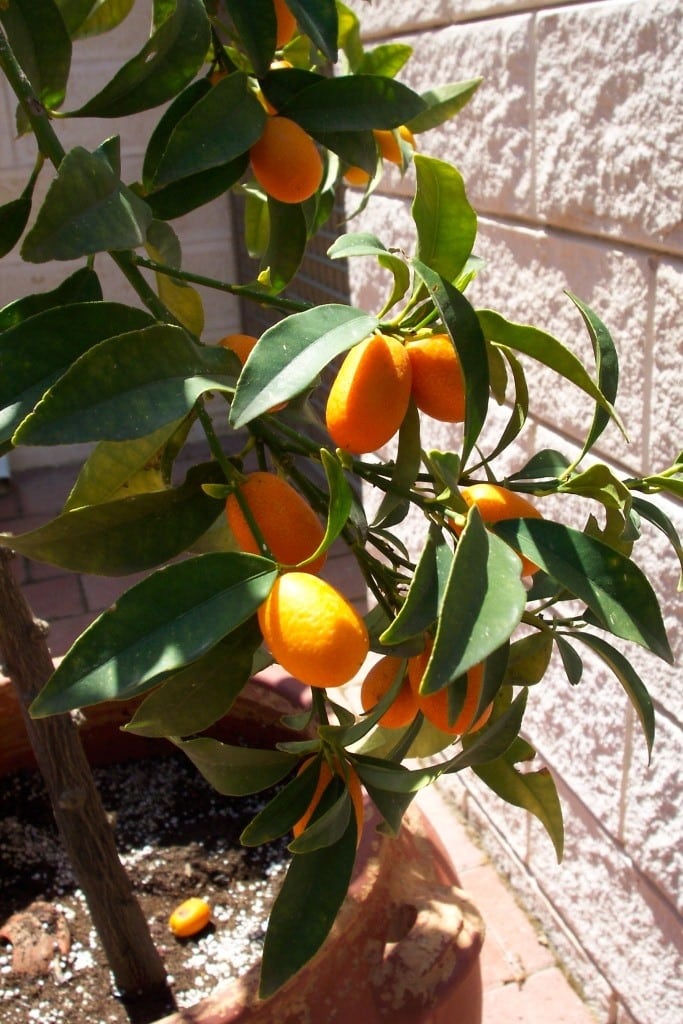
Soil
Citrus grow best in well drained and aerated, sandy loams with a topsoil 50 cm deep or more. Citrus root systems have only moderate vigour, and are concentrated in the top 30-50 cm of soil. Traditional thinking is that the site should be free of roots from other trees, as citrus roots compete poorly with roots from other trees. However, I have found this to not be the case. Low growing ground covers can insulate the soil to help retain moisture.
Good drainage and aeration are crucial to preventing “root-rot” in citrus. Low lying sites that retain rain-water should be avoided.
Trees often fail to establish in clay soils unless good aeration, drainage or mounding is provided.
pH range is preferred to be 6 to 8.
Preparing the site for planting citrus trees
Ideally, prepare your site in autumn for planting in spring.
Dig over an area of soil, a metre across and 30 to 50 cm deep. Incorporate plenty of compost, organic matter and well-rotted manure. For planting in clay soils, incorporate up to one kilogram of gypsum to the soil. If soil is particularly acid (below pH5.5) use a small amount of lime. Back fill the hole to allow organic matter to further decompose over winter.
Growing citrus in clay soils
Problems with shallow or heavy clay soils can be overcome.
If available, deep ripping will improve drainage and long term root penetration. Use 2 kg per sq metre of gypsum and a 15 cm layer of clean sand over the site. Deep ripping should be to at least a depth of 40 cm or more.
Alternatively, sandy loam can be mounded up to provide better drainage and soil depth. Be aware that the negative ionic charge of clays, will draw moisture from the loamy soil on top and dry it out. So ensure that the two are mixed reasonably well, to prevent the root systems drying out in winter.
Buying your citrus trees
Citrus trees are available to purchase all year round as container, propagated specimens, in potting mix. However, fresh trees come into many nurseries during autumn. Buy healthy trees, with fresh mature green leaves at this time. Do not transplant the trees in winter. Instead hold them over in the pot, in a sheltered, sunny spot for planting in spring.
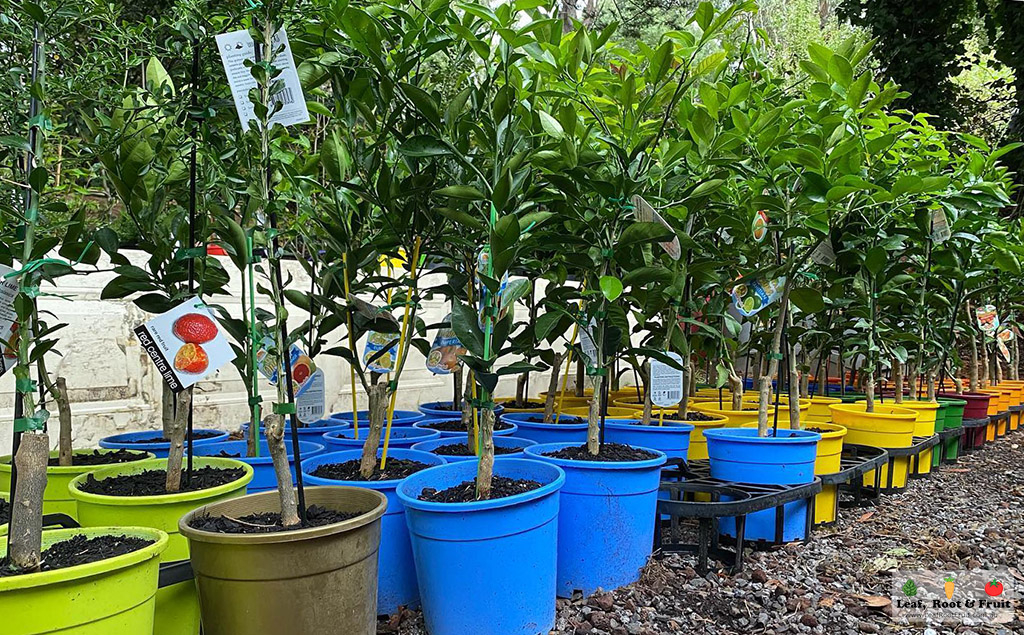
Select trees that have no evidence of damage to the stem, other than the natural kink at the bud union with the rootstock.
Remove any fruit. The presence of fruit is not an advantage except to confirm that you are purchasing the correct cultivar. In fact, the presence of fruit may indicate a tree left over from last year. Healthy young trees are preferred to these older specimens.
Transplanting citrus trees
The best time to plant citrus trees is in spring from September onwards. Soil temperature is ideally at least 16oC. Do not plant young trees in cold soil.
Washing off the potting mix
Although it may seem radical and contrary to conventional advice this is the recommended method for planting
Fill a large bucket with water and place the tree, pot and all into it to soak for 10 minutes. Slip off the pot, taking care not to damage the roots.
Gently pump the tree up and down in the water to loosen and remove the potting mix. Using your fingers, free up and extend the roots.
Continue this until all of the potting mix has been removed and it is bare rooted. Keep the tree in the water, while preparing the planting hole, but for no longer than a couple of hours.
This process allows the new roots to grow directly into the soil, thereby avoiding a sudden change in planting medium from potting mix to soil.
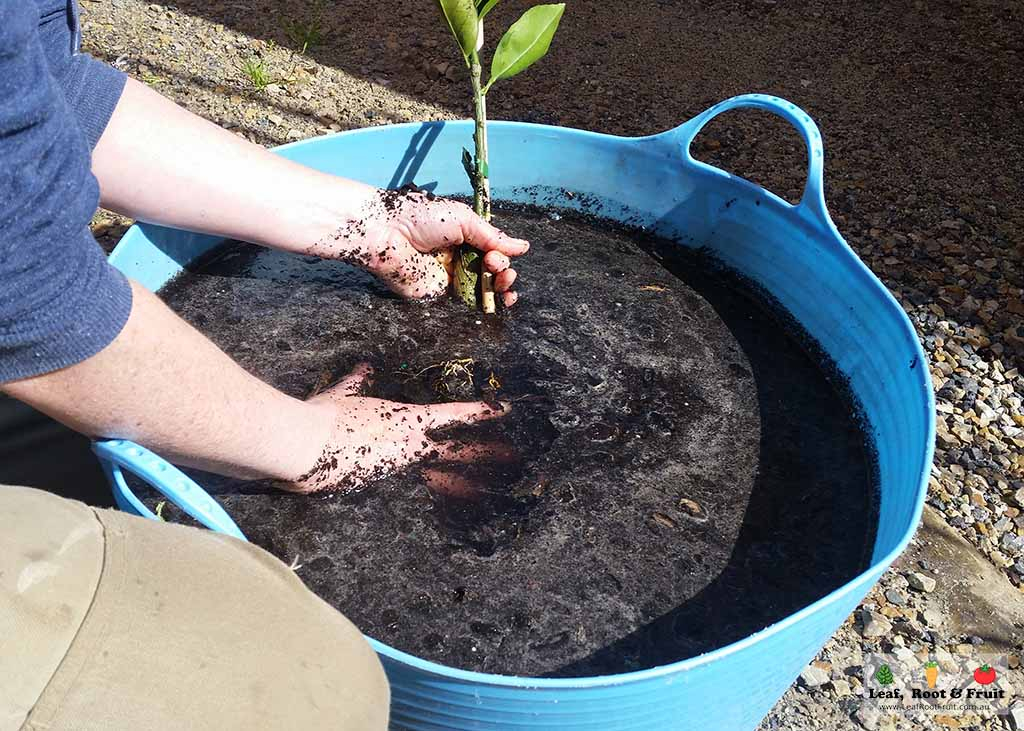
Re-dig the hole
Return to your pre-prepared site and re-dig a hole twice the width and depth of the tree container. Add further compost to the bottom of the hole. Replace enough soil, so that the tree will be replanted to the same depth, that it was in the container.
Placing the tree
Centre the tree in the hole and gently hand fill close to the roots. At the same time spread the loose roots out and down as widely as possible. Gently back-fill the soil and lightly firm down.
It is important to avoid planting too deeply because citrus are surface feeders. Later attempts to correct incorrect planting, are not usually successful.
Citrus care immediately after transplanting
Watering
Form a rim of soil 10 cm high around the tree, just outside the size of the original hole. Fill this with water from the bucket that has the surplus potting mix in it. On the following day re-firm the soil and top-up if it has sunk or cracked and a little more water.
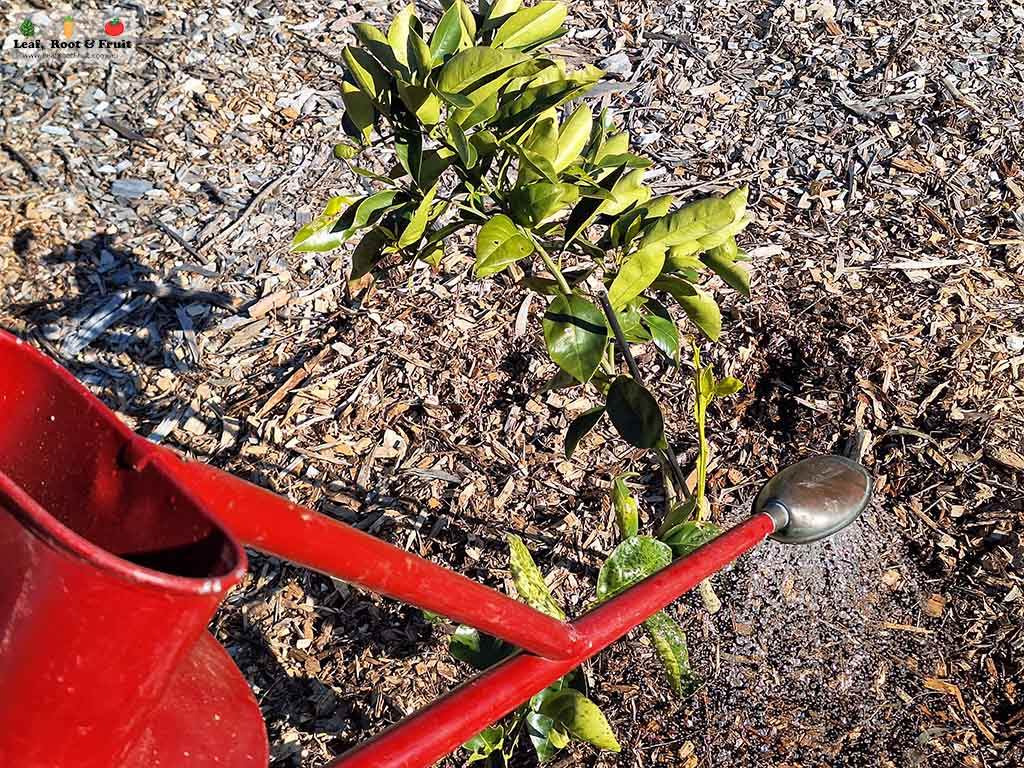
Usually, the tree only needs watering every week, unless the tree is showing signs of wilting. To check for wilting, observe the condition of new growth, this is a great way to judge when to water next. If the mature leaves feel warm and leathery (as opposed to cool and transpiring) then it may also need watering.
As a guide, watering of newly planted trees can be as little as nil (after rain) to twenty litres weekly in cool weather and up to 20 litres every second day in summer.
Mulching
Cover an area of at least a metre in diameter around the tree with an organic mulch up to 10 cm deep. This will prevent weed growth, conserve moisture, moderate soil surface temperature and help to spread and retain water.
Mulching trees in pots or tubs is just as important.
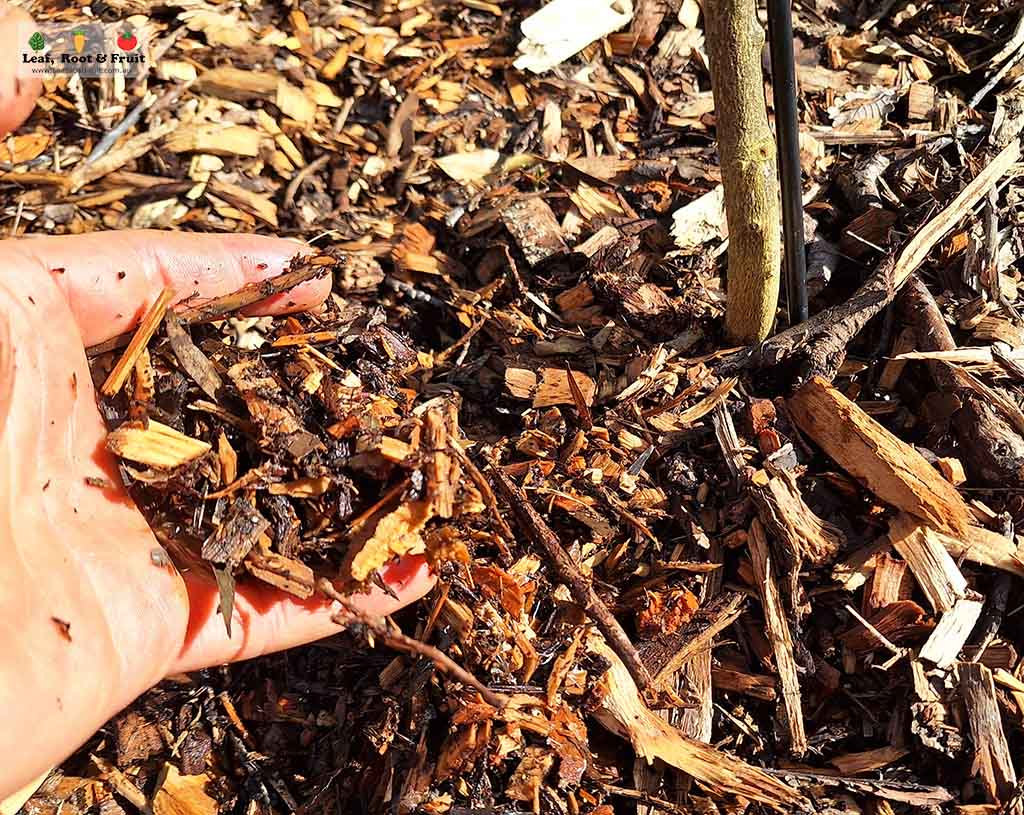
Sun and wind protection
Provide a windbreak shelter out of shade cloth or hessian in windy sites and consider staking the tree until it has established.
In hot summer weather sap flow can be affected, particular when very hot days, rapidly follow a cool period. To avoid heat and UV damage to the bark, consider painting the trunk white, with some water-based interior house paint.
Fertilising
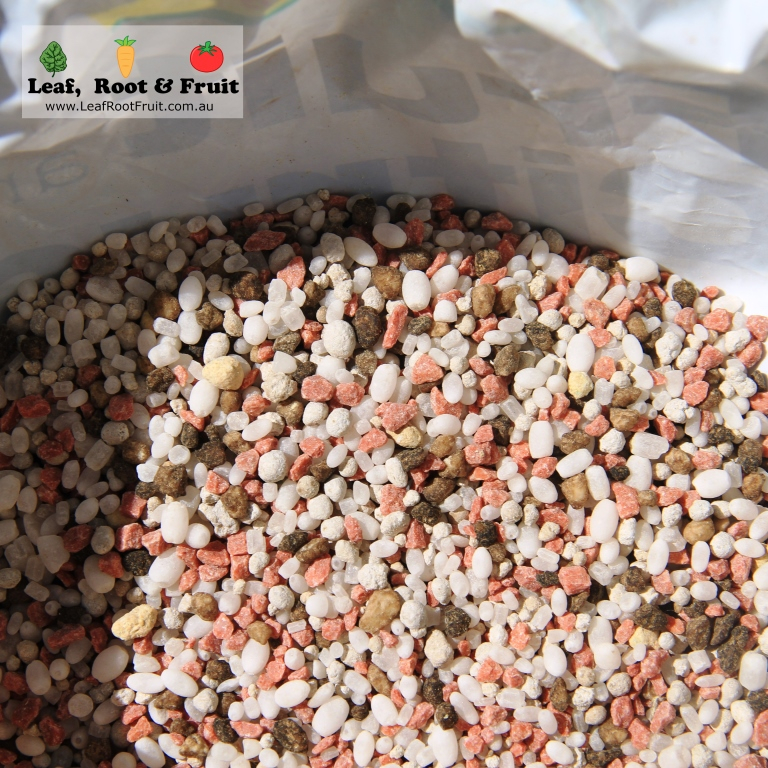
Young-rapidly growing trees, need a constant supply of nitrogen. Small regular applications give the best results.
Sprinkle a nitrogen rich fertiliser onto the moist soil and rake into the surface lightly. You can use a pre-formulated citrus fertiliser or chicken manure will work just as well.
Want to know more about Growing Citrus in Melbourne?
This is Part 2 of a 5 part guide to growing citrus in Melbourne. The links below will take you to the other four parts of my Melbourne citrus growing guide.
Citrus Growing Guide Part 1: Citrus Varieties for Melbourne
Citrus Growing Guide Part 3: Ongoing Care and Management of Citrus Trees
Citrus Growing Guide Part 4: Pruning and Shaping of Citrus Trees
Citrus Growing Guide Part 5: Citrus Pests, Diseases and Problems in Melbourne
My citrus growing guides are based on my own experience, as well as the following books. They are all invaluable resources for the home gardener based in Melbourne. I strongly recommend you have a read of them, if you want to know more about growing citrus in Melbourne:
Ian Tolley: Commonsense Citrus, 2017
Bruce Mophett & Ian Tolley: Citrus, A Gardener’s Guide, 2009.
Louis Glowinski: The Complete Book of Fruit Growing in Australia, 1997.


I have just purchased a Dwarf citrus Eureka and planned to plant it as you have advised based on Ian Tolley’s method of removing the potting soil and planting it bare rooted into my prepared soil, however Engall’s Nursery in Dural, NSW where I purchased this Eureka lemon, totally advised against doing this so now I’m confused as to how to proceed.
Grateful for any imput. Trish S (Sydney)
Hi Trish,
I’ve used both methods to plant citrus trees and both work well. I think a lot of it depends on the soil type that you are planting into. If you have good soil, then planting straight into the ground may be fine. I think Ian Tolley’s method is more useful for heavier clay soils. You also have a better climate for citrus up there, so your tree should handle the conditions better. I think either method will be fine for your tree.
Please let us know which method you go with and down the track what the outcome is.
Good Luck and Happy Gardening!
Duncan
Hi Duncan, appreciate your response to my Eureka dilemma. Contacted Ian Tolley who’s helpful response gave me the confidence to proceed with my original plan to use his method. The Eureka took off like a rocket, new growth sprouting almost immediately; now my only problem is deterring baby brush turkeys, who fit into every small nook and cranny, despite of my efforts to brush turkey proof my garden.
I agree with you that planting into fertile, well prepared soil probably would have yielded the same result but using Ian Tolley’s method makes good agrarian sense. Trish
Hi Trish,
I’m glad Ian was helpful. He’s certainly the person I’d go to for any advice on citrus.
Thanks for the update!
Duncan
When I plant l usually find that a 1:1 mixture of a good (appropriate) potting mix mixed in your soil works well . Fertilizers added as needed. I personally like organic fertilizers , herbicides & insecticides if needed. There are snail baits that are not toxic to other creatures ,God knows we’ve had a plague of them this Winter/Spring due to the amount of rainfall.
I have just purchased grapefruit,Valencia, emperor mandarin and eureka lemon, grafted trees in plastic soil filled sleeves from Aldi.
Although it’s only late April and not yet winter, should I wait until September or October to plant them ? I am in Cranbourne and we don’t usually have frosts here.
Also I have 2 possible planting spots, one receives all year round sun (very hot on summer afternoons )
And the other doesn’t get any autumn/winter sun, but gets plenty of summer sun
I’d be greatful for any tips
Thank you
Hi Jo,
Be careful with those Aldi trees, they are sometimes on rootstocks that are more suited to other climates, such as the tropics. Does it say on the label what the rootstock is?
You can plant the trees now. The soil is still warm. It just means that they won’t have as much time to get established before the onset of winter. However, if the site is sheltered, then the trees should probably be fine. Alternatively you could pot them up into something bigger and wait until October.
Please keep us updated on how you get on.
Good Luck and Happy Gardening!
Duncan
I have planted five different citrus fairly close to our fence, they are doing well it is. A great position, I always k new the root system is shallow but I now read the root systems are invasive which can cause damage to concrete. Our neighbours garage is built hard up against the fence and I am now thinking the citrus is to close to their garage floor, would be less than one metre away. Is this correct citrus roots can damage concrete if planted very close to it…is there an average of how far the roots spread…thank you
Hi Janine,
It’s great to see you being so neighborly and considering your garden’s impact beyond your boundary. Citrus are very shallow rooted trees. I’ve not noticed them to be invasive, certainly not compared to pears. If you are concerned then please arrange for someone qualified to inspect the trees and make recommendations.
Good Luck and Happy Gardening!
Duncan
Hi there I’ve just bought a dwarf lemon Meyer with Dragonfruit root stock from my local bunnings January 28th 2023 I’m located in Bathurst NSW and I was wondering if I can transfer it into my pot all should I wait until later in the spring we get frost here the lady at the shop said it was fine to pot up what do you think ? Thanks.
Hi Nathalie,
Firstly, it is likely to be “Flying Dragon” rootstock, not dragonfruit! It should be fine to pot up your lemon tree now. If it is pot bound, the sooner the better, regardless of frosts etc.
Good Luck & Happy Gardening
Duncan
This is very informative..I would like to know if citrus roots can damage and break up concrete, I thought they were quite o.k. And have planted five against a garage wall of our neighbours I have know been told they will eventually break up the garage floor..I googled this and came across a couple of American sites which supported this info. Are you able to advise me as I may need to transplant them..thank you..janine
Hi
Can you tell me where I can buy sanguinello or Tarocco
Blood orange trees?
Thanks
Hi Enza,
Daley’s nursery in QLD may have them from time to time. Otherwise, I’m not sure where you can find them. Please let us all know if you do track them down.
Good Luck!
Duncan
The information you provided was excellent and covered everything. Informative and easy to understand .l feel confident about getting my citrus trees doing their best. Thanks!
Thanks for the great feedback Gail
Best of luck with the citrus!
What potting mixture would you recommend for a Washington orange in a pot? It will have to stay in the pot for several years. Thanks Barbara
Hi Barb,
I’d use Nature’s soil Premium Potting mix. Regardless of the potting mix choice, you’ll need to feed it with a handful of decent fertilizer every month to keep it thriving.
Stay Safe & Keep Gardening!
Duncan
Hi, I am planting a dwarf grafted pomelo and a ruby grapefruit also grafted dwarf into a garden that has amazingly good soil however the garden is riddled with fibrous( surface roots ) from a tree next door i dont believe the citrus trees will have an issue as the soil does not dry out too much, should i try to remove these fibrous surface roots as much as i can , There is approx 30 cm of good loose soil before the matting of other fibrous roots and the width of the bet os 90 cm x 4.0 m with one citrus 100cm from one end and 1500 cm from the other and nothing in between except some veges,
Hi Trevor,
Ideally the roots would be removed to reduce competition. However within 6 months the roots will re-grow to compete with your citrus. This is especially the case if you add compost, fertilise and water the citrus trees heavily. I would be inclined to plant citrus trees on Trifoliata rootstock to ensure they have the vigour to compete with the already established root system.
Good Luck & Happy Gardening
Good Luck & Happy Gardening!
Hi! Thank you for your website, it is very useful and informative. I just purchased a dwarf meyer lemon tree from my bunnings couple days ago. Its my first fruit tree and I am super excited. I live in Melbourne. Should I repot it now to a bigger pot or should I wait until spring this year? Also, should I move it indoors during winter? Some resources say fertilise lemon tree four times a year, some say twice. Hope you can help me.
Congratulations on the purchase of your Meyer Lemon.
Yes, you’ll probably need to plant it up fairly soon. I would advise to feed it monthly, especially for potted trees.
You wont need to take the tree indoors during Melbourne’s winter. It will be fine outside.
Good luck with it. I hope it bares lots of fruit for you.
How often should I be watering pot planted citrus? I have a variety of finger lime, a young plant that isn’t doing so well, I believe it became slightly frost damaged a few weeks back and now the temperatures have increased in Melbourne its seeing full sun from the north from around midday through to the evening. Its 4pm in the afternoon and my temp gauge shows around 30 degrees C at the top of the soil.
The pot is 300x270mm, soil is the bunnings citrus blend with some horticultural sand and charcoal mixed in.
So I am concerned I’m battling with a plant that was burnt by frost and now, one that perhaps is seeing too much sun or not getting enough water. I gave it a deep watering last night and today, the first inch or two registers as dry on my moisture meter, below that is wet however.
Hi Hasan,
Asking how often should you be watering is like asking how long is a piece of string! It depends on so many different factors. Keep an eye on the soil moisture levels by sticking your finger into the soil. That should enable you to adjust your watering accordingly. Also, don;t forget to add a saucer underneath the pot to help the water soak back into the potting mix via capillary action.
Happy gardening
Duncan
Hi! First of all, thanks very much for such detailed information! I have a question around a planting site for Lemon (Lots Lemons, dwarf), Mandarine (Emperor, dwarf) and Valencia trees that we would like plant. We have some space along a fence and neighbours’ garage (approx 2.7, tall), but we are on the Southern side i.e. while there’s enough sun in the summer when the sun is tall, the site is shaded in the late autumn, winter and early spring. Does it mean that the trees will be able to grow during the summer but the fruit will not fully ripen in the winter due to the shading?
Thanks!
Hi Sergey,
Thanks for the great feedback. It’s difficult to give accurate advice without actually seeing the site. Given the trees are dwarf (which I don;t usually recommend) they are not going to grow very tall and chase the sun. The trees will need warmth in winter to ripen the fruit. This is not such an issue for lemons, but will be important for the mandarin and orange. If you can, plant the trees away from the wall as far as possible. Or perhaps find an alternative site for them.
Good luck and happy gardening!
Duncan